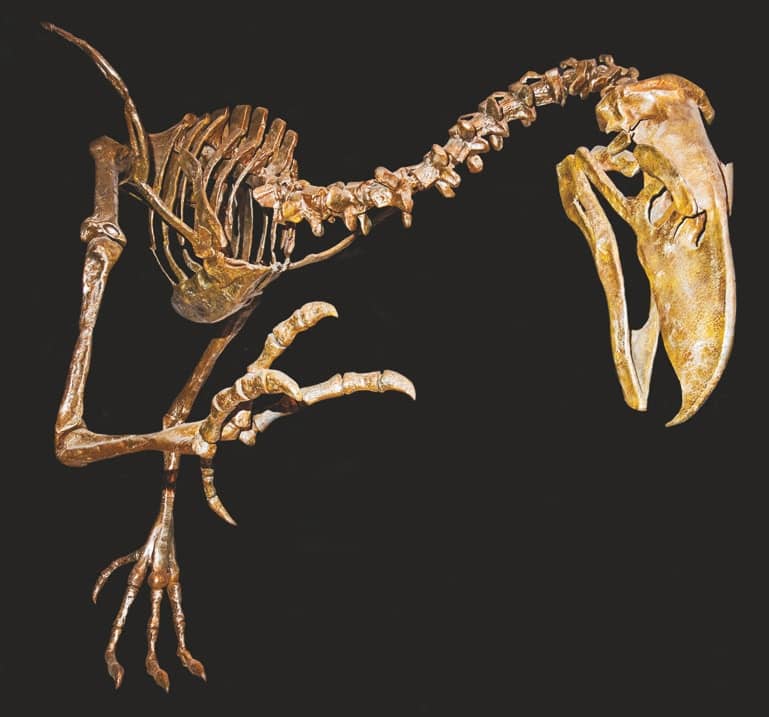The Rise & Fall of the Terror Birds
Muse Science Magazine for Kids
|March 2020
AFTER THE DINOSAURS, A NEW PREDATOR REIGNED IN SOUTH AMERICA. FOR A WHILE.

Welcome to Florida . . . 3 million years ago. One day this land will be dominated by gentle breezes, palm trees, and grandparents. But today, it is ruled by a terrifying beast.
This monster stands taller than a basketball hoop. It has an enormous razor-sharp beak that can slice through flesh and crack bones. If it lays eyes on you, there’s little point in running away. Long, strong legs make it one of the fastest animals on land. Its speed and strength are rivaled only by its appetite for fresh meat. This creature is Titanis walleri, the largest of all terror birds.

Terror birds (family Phorusrhachidae) were gigantic, flightless birds that rose to the top of the food chain after the Cretaceous Period came to a close. For more than 60 million years, terror birds ruled the roost as a top predator. Then they disappeared.
The rise and fall of the mighty terror birds is a story about a change. It’s a story about evolution’s winners and losers. And the terror birds were big, big winners . . . until they weren’t.
A Changing Planet
Like most of today’s plants and animals, the story of the terror birds begins in the Cretaceous Period. Life on Earth changed a lot during the Cretaceous. The huge land mass of Pangaea split apart. Over millions of years, the Earth’s plates moved inch by inch through the process of continental drift. Eventually the continents of Asia and North America and Africa formed. However, land bridges still connected these giant landmasses, allowing plants and animals to move back and forth between the new continents.
This story is from the March 2020 edition of Muse Science Magazine for Kids.
Subscribe to Magzter GOLD to access thousands of curated premium stories, and 10,000+ magazines and newspapers.
Already a subscriber? Sign In
MORE STORIES FROM Muse Science Magazine for Kids

Muse Science Magazine for Kids
ANIMAL FIREFIGHTER TO THE RESCUE
Can animals help manage the risks of deadly wildfires?
3 mins
Muse July 2025: The Story Behind Wildfires

Muse Science Magazine for Kids
FIRE DANGER
WHY THE RISK OF WILDFIRES KEEPS GROWING
4 mins
Muse July 2025: The Story Behind Wildfires

Muse Science Magazine for Kids
The Miller NEW Normal
WHAT TODAY’S WILDFIRES TELL US ABOUT OUR FUTURE
8 mins
Muse July 2025: The Story Behind Wildfires

Muse Science Magazine for Kids
WOMEN AND FIREFIGHTING: A GOOD FIT
Jessica Gardetto is a firefighter. Her father was, too. “I grew up with my dad coming home smelling like wildfire and covered in soot,” she says.
1 min
Muse July 2025: The Story Behind Wildfires

Muse Science Magazine for Kids
What is happening on your fingertips when they get all wrinkly in a hot tub?
—Felix G., age 10, Montana
1 mins
Muse July 2025: The Story Behind Wildfires

Muse Science Magazine for Kids
WHEN the SMOKE CLEARS
THE LINGERING EFFECTS OF THE RECENT PACIFIC PALISADES AND ALTADENA EATON FIRES
6 mins
Muse July 2025: The Story Behind Wildfires

Muse Science Magazine for Kids
PICKING TEAMS
Keep it fair with a strategy that relies on geometry.
2 mins
Muse July 2025: The Story Behind Wildfires

Muse Science Magazine for Kids
SHAN CAMMACK
WILDLIFE BIOLOGIST AND FIRE SAFETY OFFICER
3 mins
Muse July 2025: The Story Behind Wildfires

Muse Science Magazine for Kids
Scientists Create Mice With Woolly Mammoth-Like Fur
RESEARCHERS AT A COMPANY IN TEXAS ARE WORKING TO CREATE A LIVING ANIMAL THAT RESEMBLES THE EXTINCT WOOLLY MAMMOTH. Recently, they produced mice with traits of the large mammal. The mice all have coats with mammoth-like fur, and some of the small mammals also have genes that help them store fat. Both features would help the animals survive in the cold Arctic, where the woolly mammoth once lived.
1 min
Muse July 2025: The Story Behind Wildfires

Muse Science Magazine for Kids
Cool Sunshade Added to the Nancy Roman Space Telescope
THE NANCY ROMAN SPACE TELESCOPE IS A NEW TELESCOPE THAT NASA IS BUILDING AND WILL LAUNCH INTO SPACE, LIKELY IN EARLY 2027.
1 min
Muse July 2025: The Story Behind Wildfires
Translate
Change font size

